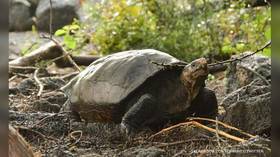Giant tortoise feared extinct for over 100 years found on Galapagos Islands (PHOTOS)

A species of giant tortoise thought to have gone extinct over a century ago was found on the Galapagos island of Fernandina, stunning researchers and bringing hope to conservationists.
According to Ecuador’s Ministry of the Environment, the female Fernandina Giant Tortoise found Sunday is likely over 100 years old. While genetic tests are still being conducted, the experts at the Giant Tortoise Restoration Initiative (GTRI) say they have made the first confirmed sighting of the species since 1906.
BREAKING NEWS! GC’s own @wacho_tapia just returned from Fernandina Island in #Galapagos, where they discovered a female #tortoise. Tortoises on Fernandina have been thought to be extinct for over 100 years, so this is a monumental finding! Photos © GNPD, W. Tapia pic.twitter.com/fhQpIzsHmM
— GalapagosConservancy (@SaveGalapagos) February 20, 2019
Despite being listed as “Critically Endangered (Possibly Extinct)” for such an extensive period of time, bite marks, droppings, and footprints found over the years had given researchers hope that some of the animals were still alive.
Also on rt.com ‘Magnificent!’: Trump’s jaguar appreciation tweet gets trolled over sons’ hunting hobbySuch traces of the elusive turtle motivated the successful expedition, and new signs found in the area indicate that there might be even more of the giant reptiles on Fernandina Island. The species is unique to the Galapagos, one of 14 native to the island chain.
NOTICIA MUNDIAL | En la isla Fernandina - #Galápagos, la expedición liderada por @parquegalapagos y @SaveGalapagos, localizaron un espécimen (hembra adulta) de la especie de tortuga Chelonoidis Phantasticus, que se creía extinta hace más de 100 años. pic.twitter.com/51HbqWcwMG
— Marcelo Mata (@Marcelo_MataG) February 19, 2019
“This encourages us to strengthen our search plans to find other (tortoises), which will allow us to start a breeding program in captivity to recover this species,” said Danny Rueda, the director of the Galapagos National Park.
A Fernandina tortoise, presumed to be extinct since 1906, has been FOUND! She was discovered in an expedition for #ExtinctorAlive by @ForrestGalante. This tortoise was hiding in the brush of a volcano in the Galapagos and was identified by the look of her shell and face. pic.twitter.com/R4a2YOdI8j
— Animal Planet (@AnimalPlanet) February 20, 2019
In order to facilitate the repopulation process, the tortoise was immediately taken to a breeding facility on nearby Santa Cruz Island and put under the care of park rangers.
The Galapagos were made into a national park in 1959 in order to preserve the island ranges’ rich biological diversity, which helped inspire Charles Darwin’s theory of evolution. Despite the island deriving its name from its giant tortoises, volcanic activity, invasive species, and human exploitation have resulted in the animals becoming endangered.
Like this story? Share it with a friend!














